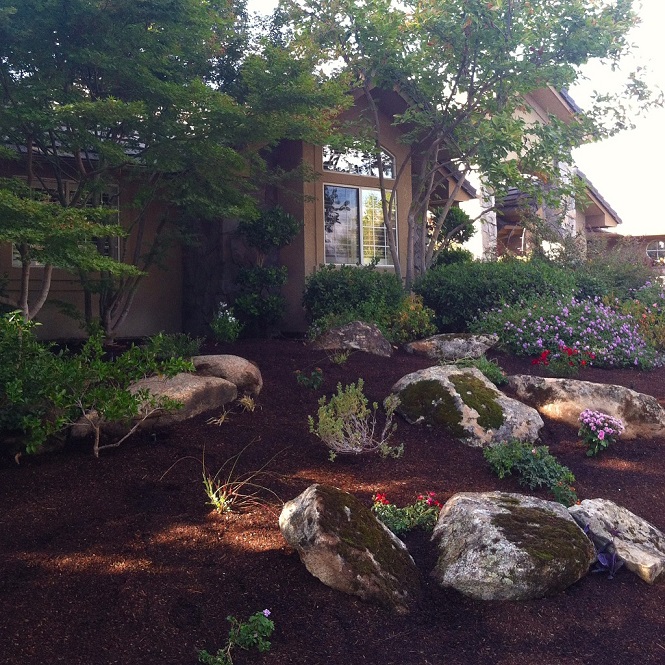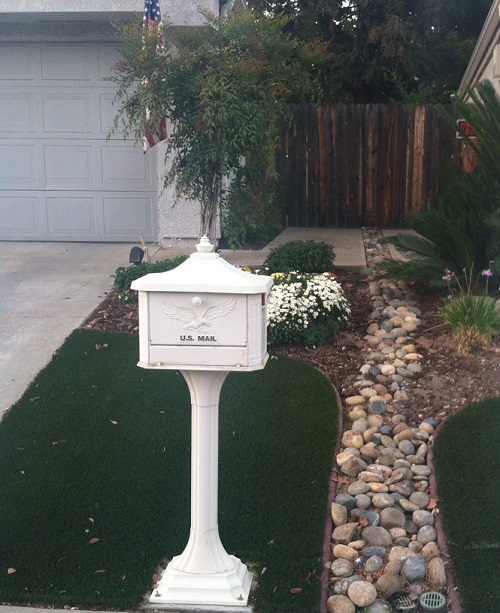 When my family and I lived in North Dakota, we had a beautiful green lawn (grass with a healthy mixture of clover). We had a reel mower so we weren’t using fossil fuels or causing excessive noise pollution while mowing. We didn’t use synthetic fertilizers, weed killers or other chemicals on anything we grew; it was all a pesticide-free zone. We didn’t use potable water to maintain our lawn; our climate usually gave our lawn the rainfall that it needed to remain green most of the spring, summer and fall. We also had a rain barrel for any outdoor watering needs like shrubs and flowers. So I know, with the right conditions, a perfectly imperfect lawn can be had.
Since moving to California, a state in the middle of a historic drought, I have a whole new outlook on what makes a beautiful lawn and, as I see neighbor after neighbor tearing out their lawns in favor of artificial grass, I started to wonder if a carpet of synthetic plastic could actually be an eco-friendly alternative.
When my family and I lived in North Dakota, we had a beautiful green lawn (grass with a healthy mixture of clover). We had a reel mower so we weren’t using fossil fuels or causing excessive noise pollution while mowing. We didn’t use synthetic fertilizers, weed killers or other chemicals on anything we grew; it was all a pesticide-free zone. We didn’t use potable water to maintain our lawn; our climate usually gave our lawn the rainfall that it needed to remain green most of the spring, summer and fall. We also had a rain barrel for any outdoor watering needs like shrubs and flowers. So I know, with the right conditions, a perfectly imperfect lawn can be had.
Since moving to California, a state in the middle of a historic drought, I have a whole new outlook on what makes a beautiful lawn and, as I see neighbor after neighbor tearing out their lawns in favor of artificial grass, I started to wonder if a carpet of synthetic plastic could actually be an eco-friendly alternative. 
Here is what I discovered:
The Benefits of Artificial Grass
- You will no longer need to mow your lawn. No more gas-powered mower, no more noise pollution and no more spending your weekends cutting the lawn.
- You will no longer need to use fertilizers, weed killers or other toxic chemicals on your lawn, which is better for the health of your family and the environment.
- You will no longer need to water your lawn, avoiding the needless waste of water. The Southern Nevada Water Authority stated on its website that a homeowner “saves 55 gallons of water per year for every square foot of natural grass replaced with synthetic.” And some water companies in drier areas will offer a cash rebate when you install an artificial turf or transition to native, drought-tolerant landscaping.
- You will always have a green lawn with little maintenance that will last around 15 to 25 years.
- The upfront cost to purchase and install your fake grass ranges from $5 to $20 per square foot, but then you won’t have any additional costs until you need to replace it.
- Some synthetic grass products are partially made with recycled materials.
The Environmental Costs of Artificial Turf
- Artificial grass is a petroleum-based product that creates waste and pollution during its manufacturing.
- And, while some products are partially made with recycled materials, it is not biodegradable. So, even though it lasts from 15 to 25 years, it will eventually end up in a landfill.
- I have seen people in my city watering their artificial turf to remove dust and dirt and also using leaf blowers to remove leaves and other debris (which negates the water and noise pollution benefits mentioned above).
- Critics of artificial grass say it is an environmental heater. It absorbs heat and feels hot to the touch in direct sun. Living plants, on the other hand, have a cooling effect when the air temperature is high.
- Our soil is important, as written about in “The Soil Will Save Us“, by Kristen Ohlson. She explained that there is “a vast kingdom of creatures under our feet – billions of microorganisms in a tablespoon of soil – that take the carbon dioxide that plants pull from the atmosphere and turn it into life-giving soil carbon.” Artificial grass is not a viable way to encourage healthy soil.
- Artificial grass will deteriorate under UV radiation, and as it does, the plastic falls to pieces, according to Change-making.com. “Bits of plastic and shreds of sheeting drift around our city neighborhoods,” wrote the website. “They’re unsightly, they get stuck in foliage and waterways, they reduce property values, and someone has to pick up all that litter.”
The Alternatives
1. Consider ground covers or eco-lawn varieties that allow you to reduce or eliminate mowing, watering and chemicals. Check for native varieties in your area, including:- Blue Star Creeper (Isotoma fluviatillis) ground cover is fast growing and can take heavy foot traffic.
- Elfin Thyme (Thymus serpyllum) is sun-loving, very drought tolerant and can stand foot traffic. It forms a tight solid mat of green foliage that blooms with light pink flowers in summer.
- Fleur de Lawn is a flowering eco-lawn mix with low-growing perennial flowers that change color and texture through the seasons. It was developed at Oregon State University through research on eco-friendly landscapes.
To find out more information on these ground covers, visit http://protimelawnseed.com/collections/eco-and-alternative-lawns.
2. Grow food instead of grass. The international movement of Food Not Lawns is a global community of gardeners working together to grow and share food, seeds, skills and resources.
3. Use native plants, which provide food and homes for your local wildlife, birds, butterflies and beneficial insects. They are also suited to your particular climate.
4. Paint your lawn. Yes, this is really a thing and, after learning about it, I think I might give it a try in our yard. I’ll keep you posted. Find out more about lawn paint at http://www.lawnlift.com/.